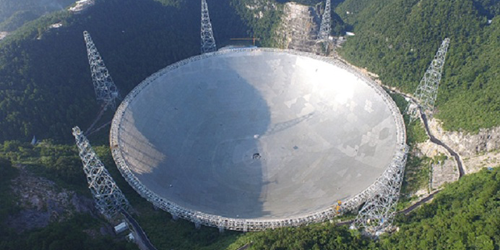Detecting Dark Photons with Radio Telescopes
In recent years, physicists have become interested in the idea of ultralight dark matter, which posits that dark matter is composed of extremely low-mass bosons. One such candidate is the “dark photon,” which is predicted to interact weakly with matter by coupling to regular photons—a process called kinetic mixing. Now Haipeng An at Tsinghua University in China and colleagues propose that it may be possible to detect dark photons via their interactions with free electrons in radio telescopes. Using data from the Five-hundred-meter Aperture Spherical Telescope (FAST) in China, An and colleagues set an upper limit for the probability of such interactions [1].
At dish-shaped radio telescopes such as FAST, incoming radio waves excite oscillations of the free electrons in the dish, generating a reflected signal that is detected by the telescope’s central receiver. If dark photons interact with free electrons in the dish via kinetic mixing, they too should generate electromagnetic waves with a frequency that depends on the dark photons’ mass. In principle, the signature of this interaction should be detectable within the overall radio signal picked up by the telescope. An and colleagues looked for signs of kinetic mixing among observations that FAST had made in the 1–1.5-GHz frequency range. Finding no such signature, they calculate that the dimensionless value 𝜖, which quantifies the kinetic-mixing rate, is no larger than 10−12.
In addition to using existing data from FAST, the researchers projected sensitivities for dark-photon detection using the Low-Frequency Array in Europe and the forthcoming Square Kilometre Array in Australia and South Africa. Next, they intend to analyze data from space-based radio telescopes, which are sensitive to dark-photon-induced signals at frequencies below those accessible to terrestrial radio telescopes.
–Allison Gasparini
Allison Gasparini is a freelance science writer based in Santa Cruz, CA.
References
- H. An et al., “Direct detection of dark photon dark matter using radio telescopes,” Phys. Rev. Lett. 130, 181001 (2023).




